Seasonal Item: Canned Pumpkin
The fall season is in full swing and this time of the year brings a new crop of seasonal fruits and vegetables. Canned pumpkin is among the seasonal items offered through the Food Distribution Program on Indian Reservations (FDPIR) and can be used in many ways.
 Pumpkins are a good source of vitamins A and C and are naturally low in cholesterol and sodium. As a member of the squash family, pumpkins come in many shapes and sizes but are typically known to be round and orange. Canned pumpkin can be used in many ways. Mix it with Greek yogurt and cinnamon to make a dip for apples, or use it as a base for a savory pumpkin bisque. Need more ideas on how to use canned pumpkin? Check out this Pumpkin Smoothie recipe!
|
First Catfish Distribution to FDPIR
 We are delighted to announce that the first fair share distribution of catfish, the newest traditional food offered through FDPIR, was delivered to Indian Tribal Organizations (ITOs) from late September to early November. The catfish fillets are individually frozen, skinless and boneless, and have a mild flavor and firm texture. Catfish fillets are very versatile and can be baked, broiled, or grilled. Check out the Baked Catfish recipe below from Carmen Robertson, nutritionist for Choctaw Nation of Oklahoma!
Catfish offers a variety of health benefits. Including catfish and other seafood in your diet helps to meet protein needs and boosts intake of vitamins and healthy fats and fatty acids. A 4 ounce catfish fillet counts as 4 ounce-equivalents for the MyPlate Protein Food Group. MyPlate recommends eating a variety of protein foods throughout the week, including at least 8 ounces of cooked seafood.
Baked Catfish (makes about 4 servings)
Ingredients:
- 4 catfish fillets
- 1 onion, sliced
- 2 lemons (1 for garnish)
- 1/2 teaspoon garlic powder
- Salt and pepper to taste
Directions:
- Preheat oven to 375°F.
- Slice onion, lemon and place in bottom of the pan.
- Season fish with garlic powder, salt and pepper to taste.
- Place fish on top and cover with foil.
- Bake until fish is flakey, approximately 15-20 minutes.
|
Shell Egg Pilot Expansion
 This October, 18 Indian Tribal Organizations (ITOs) participating in FDPIR were added to the pilot to distribute shell eggs as part of their monthly food package benefit. One dozen shell eggs replace the powdered egg mix participants receive each month. The addition of these 18 ITOs increased participation in the pilot to a total of 32 ITOs, which represents almost 31 percent of ITOs in FDPIR. Tribes use the Fresh Fruits and Vegetables Order/Receipt System (FFAVORS) to place orders for shell eggs to be delivered through the United States Department of Agriculture (USDA) Department of Defense (DoD) Fresh Fruit and Vegetable Program (USDA DoD Fresh) produce vendor. To view the list of 18 ITOs, see the announcement in the July 2018 "FDPIR Connection" e-letter! USDA will continue to evaluate the pilot and work collaboratively with DoD and participating ITOs to improve and allow for future expansion of the shell egg pilot.
In an effort to ensure the USDA DoD Fresh Program is delivered efficiently, effectively, and with integrity and a focus on customer service, we have a new email address dedicated to the USDA DoD Fresh Program. Please reach out to the USDA DoD Fresh Program Team at USDADoDFresh@fns.usda.gov with any general questions.
For concerns regarding product received through the USDA DoD Fresh Program, ITOs should continue to first contact their designated Defense Logistics Agency (DLA) service representative for direct customer service, the produce vendor, and the appropriate Food and Nutrition Service (FNS) Regional Office. If issues continue to be unresolved, please contact the USDA DoD Fresh Program Team using the new mailbox above.
|
New Video and Photos on the FDPIR Sharing Gallery
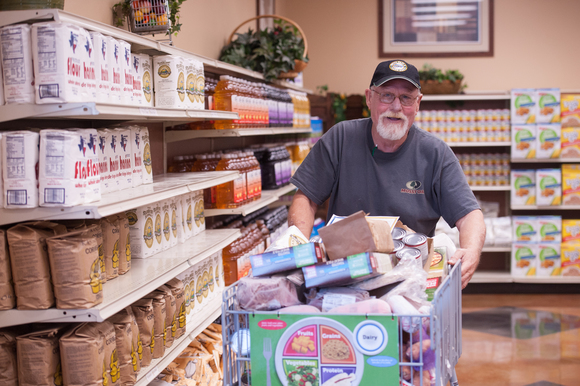 |
In this new photo on the FDPIR Sharing Gallery and USDA Flickr site, Chickasaw Nation FDPIR client Joe Harris pushes a grocery cart full of food at Purcell Nutrition Services in Purcell, OK, on November 17, 2016. Chickasaw Nation FDPIR features a grocery store model where clients can select from a variety of fruits, vegetables, grains, dairy, proteins, legumes, and traditional foods for their monthly food packages. Photo by Don Hamilton for USDA.
The New FY 2019 FDPIR Income Guidelines are Here!
Every year, at the beginning of each Federal fiscal year (FY), FNS posts the new eligibility income guidelines for FDPIR. The income guidelines set the net monthly income limit for each household size and are used to determine eligibility for the program. These guidelines, commonly referred to as Exhibit M and part of the FNS Handbook 501, also include allowable income deductions for earned income, dependent care, child support, medical expenses, home care meals, and shelter and utilities by regional area. If you are an FDPIR administering agency, please make sure you are using the FY 2019 Net Monthly Income Standards which went into effect starting October 1, 2018!
USDA Encourages Conference Attendees to “Take a Fresh Look at FDPIR”!
USDA staff attended the Third Annual Native American Nutrition Conference, hosted by the Shakopee Mdewakanton Sioux Community and the University of Minnesota, October 2-5, 2018, outside Minneapolis. This conference brings together tribal officials, researchers, practitioners, and others to discuss the current state of Indigenous and academic scientific knowledge about Native nutrition and food science. USDA partnered with two representatives from local FDPIR programs, Florence Calabaza, Food Distribution Director at Five Sandoval in New Mexico, and Carmen Robertson, Nutritionist at Choctaw Nation of Oklahoma (pictured above with session moderator and USDA nutritionist Akua White), to offer breakout sessions highlighting significant improvements to the FDPIR food package in recent years and nutrition education efforts. USDA also interacted with conference attendees through an exhibit table (pictured below), featuring posters highlighting the foods available through FDPIR and photos of several different FDPIR programs. Through these efforts, USDA and our program partners were able to answer many questions about FDPIR and help those attending better understand how the program works in their communities.
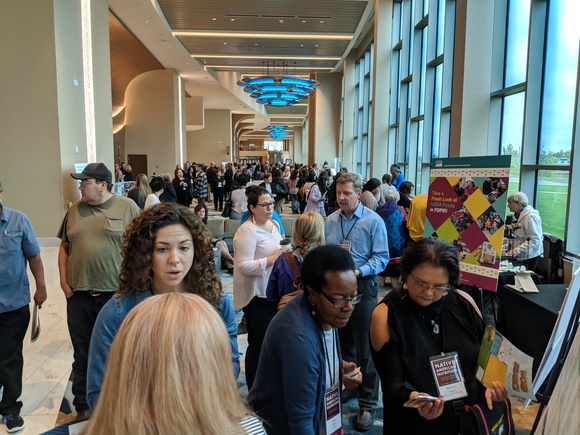 |
Eat Together, Eat Better – 21st Annual Midwest Regional FDPIR Conference in Cloquet, Minnesota
In August, USDA staff attended the 21st Annual Midwest Regional FDPIR Conference in Cloquet, Minnesota, hosted by the Fond du Lac Band of Lake Superior Chippewa. This year, more than 100 FDPIR staff spent the week learning and networking. The conference brought together food distribution program directors, certification staff, warehouse managers, and tribal nutritionists from across the Midwest and Northeast regions. Discussions centered on topics such as civil rights, eligibility and certification of households in FDPIR, nutrition education, FDPIR funding, and food package workgroup updates. The conference also featured a tour of the Fond du Lac Journey produce farm, a visit to a wild rice processing facility, and a Cooking Matters session titled “How to Teach Nutrition to Your Clients” (read more and see photos below). Additionally, USDA staff used this opportunity to interact with attendees to provide more detailed information on USDA programs such as the USDA DoD Fresh Program. This visit was invaluable as USDA continues to work collaboratively with the FDPIR community to improve the food package and support nutrition education.
Midwest Region Nutrition Education Tour through Farms, Gardens, and Warehouses
As part of the Annual Midwest and Northeast Regional FDPIR Conference in Minnesota in August, the Midwest Region Nutrition Advisory Committee held a meeting to help foster and strengthen nutrition education within each FDPIR program in FY 2019. Afterwards, attendees took part in a nutrition education tour of a wild rice lake and processing farm, a produce farm, and an FDPIR warehouse.
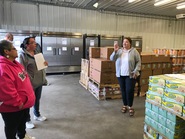 The Committee partnered with Cooking Matters to present a fun, interactive session on “how-to” teach quick nutrition education with clients. Examples included poster boards and guessing how much sugar and fat are in popular foods and beverages. Attendees were actively engaged to help them learn how to conduct these simple activities with clients. The instructor conducted taste-testing with less familiar items by preparing a delicious Blueberry Cornmeal Cake and Slow Cooker Posole. This sparked ideas among the attendees who enjoyed the flavors and took the recipes home. The instructor also conducted a “warehouse” nutrition education tour at the Fond du Lac warehouse (pictured above to the right), showing attendees how they can teach nutrition label reading and promote healthy choices using USDA Foods.
|
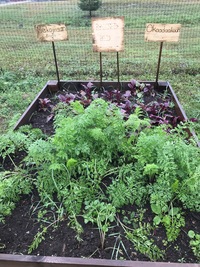 |
|
Afterwards, the attendees visited the Fond du Lac Journey garden (Babaamaadiziwin Gitigaan in Ojibwe) – a nearby produce farm that engages youth in gardening, selling produce, and nutrition education. The garden also teaches the native Ojibwe language, as produce is labeled in both the native language and English (pictured to the left). Produce from the farm is sold at the farmer’s market. Attendees had an opportunity to learn how the farm supports the local community.
|
|
Lastly, attendees had a unique opportunity to visit a wild rice lake and processing farm (pictured to the right and below). The farmer discussed how the wild rice was traditionally harvested, processed, and shipped locally. He also shared some of the challenges in growing and harvesting wild rice.
Overall, attendees really enjoyed learning about nutrition education opportunities for FDPIR and the overall community.
|
|
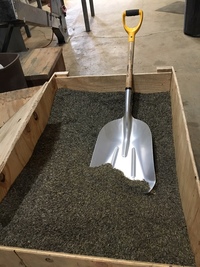 |
Update on Automated Inventory System Support
Doug Friesen, who managed the Automated Inventory System (AIS) and provided assistance to its users for more than 25 years, retired in July 2018. Upon his retirement, the Web-Based Supply Chain Management (WBSCM) Service Desk was designated as the point of contact for AIS support. After capturing incident information, the Service Desk forwards AIS issues to the Food Distribution Division’s Technology Branch.
During this time of transition, the absence of technical and user documentation for AIS has created challenges for the support available to AIS users. The Technology Branch has been documenting AIS knowledge to improve support, and all AIS users are invited to share any emails or other resources related to previous issues and their solutions. Please forward this information to Mike Baker.
To ensure the WBSCM Service Desk and Technology Branch have all the information needed to begin analysis and identify possible solutions with minimal need for follow-up questions, please be sure to include as much detail as possible, including:
- Detailed description of problem
- Transaction and/or procedure being performed
- Text of error message(s)
- Screenshot(s)
- Software version and system information
Please remember that USDA and the WBSCM contractor (CACI) cannot use peer-to-peer connection software to remotely log in to an ITO’s network or computers to review files and make changes to configurations. This type of software is prohibited due to security risks.
For AIS support, please contact the WBSCM Service Desk or call (877) 927-2648.
The Latest on Automated Inventory System Development
FNS is evaluating a set of proposed software replacement options for the Automated Inventory System (AIS). This action is due to specific requirements identified through past site visits and by the AIS Steering Committee. Once a selection is made and agreements are in place with service provider(s), development will begin.
In August, CACI hired a new staff member, Ryang Shim, who is familiar with the type of code used to create AIS. Ryang will assist with maintenance of the legacy application until the replacement system is ready.
New User Requests for WBSCM and FFAVORS
Each person
who will be accessing the Fresh
Fruits and Vegetables Order/Receipt System (FFAVORS) and/or Web-Based
Supply Chain Management system (WBSCM) is assigned a unique user profile.
Individuals who represent multiple organizations will have a separate user profile
for each of these organizations.
Both
applications use eAuthentication
(eAuth) to manage login credentials. Only one eAuth account may be linked per
user profile within the same application; however, the same eAuth account(s)
may be used for FFAVORS and WBSCM.
Creating an eAuth
account will not automatically grant access to WBSCM or FFAVORS. A user profile
must be created by administrators within the respective application.
New users
should request access as follows:
-
FFAVORS: Contact your current Department of Defense (DoD) representative to request access. If you do not know your DoD contact(s) or have trouble accessing FFAVORS with your new login ID and password, the FFAVORS Help Desk can assist you. Additional tips can be found in the FFAVORS f.a.q.
-
WBSCM: Contact the User Administrator for your organization (SDA, RA, ITO, etc.) to request access. Additional tips can be found in the WBSCM f.a.q.
Note: User Administrators can find guidance on creating a new
user profile in WBSCM under Help ->
Training -> Job Aids -> General Help -> WBSCM User Administration.
After the
profile has been created in FFAVORS or WBSCM, the new user will receive an
email with instructions to create, activate,
and register their eAuth account. Most errors encountered
during registration result from selecting the wrong link in the email message
or not entering the Last Name and Email exactly the same way as in
FFAVORS/WBSCM.
Help for Forgotten Login Information
The service
desk teams for WBSCM and FFAVORS cannot recover user login credentials. These
are maintained in a separate system called eAuthentication.
To recover forgotten information, self-service tools are available from the
login screen via the I forgot my User ID
| Password links.
To
recover forgotten User ID(s), click on User
ID. After entering your information, you will receive a list of any
User ID(s) linked to this email.
To reset a
forgotten Password, click on Password.
You will be prompted to enter your User ID and answer the security questions
you previously set up for your eAuthentication profile. After confirming your
identity, you will be prompted to enter a new password. This action will also
unlock your account if you had entered the wrong password too many times. Note: The Change
my Password link can be used to update your account only if you know
your current password.
For your
convenience, a shortcut to the password reset tool is also provided on the webpages
for WBSCM
and FFAVORS:
If you have
forgotten both your password and your security question responses:
-
Users with a LincPass (USDA-issued ID) should contact the eAuthentication Service Desk for assistance at 1-800-457-3642, option 1.
-
Users without a LincPass will need to reestablish access to FFAVORS and/or WBSCM with a new login ID. To update FFAVORS, contact the FFAVORS Help Desk. For WBSCM, contact the user administrator for your organization.
USDA staff will be participating in this upcoming meeting in 2019. We look forward to the opportunity to meet you and hope to see you there!
Week of June 9: National Association of Food Distribution Programs on Indian Reservations (NAFDPIR) Annual Conference in Philadelphia, Mississippi.
 1. Click here. Or you can go to the Food Distribution website and click on the red envelope on the row of social media icons on the top right of the page.
2. Enter your email address and click "Submit."
3.
Check the boxes to select your topic(s) of interest. For these
e-letters, scroll down to the Food Distribution category and click the
plus sign to the left of the check box to expand the list and view all
the topics. Select any of these topics to receive the general e-letter
plus the corresponding program-specific e-letter(s) of your choice:
*USDA Foods --> receive all "USDA Foods from Farm to Plate" e-letters
*Commodity Supplemental Food Program (CSFP) --> receive "Household Highlights"
*The Emergency Food Assistance Program (TEFAP) --> receive "Household Highlights"
*Food Distribution Program on Indian Reservations (FDPIR) --> receive "FDPIR Connection"
*Schools/Child Nutrition Commodity Programs --> receive "Spotlight on Schools"
4. Visit the subscriber preferences page any time you would like to review, add, or delete subscriptions. Questions? Contact USDAFoods@fns.usda.gov.
5. Share the e-letter and new subscriber link with interested colleagues and friends!
|
|